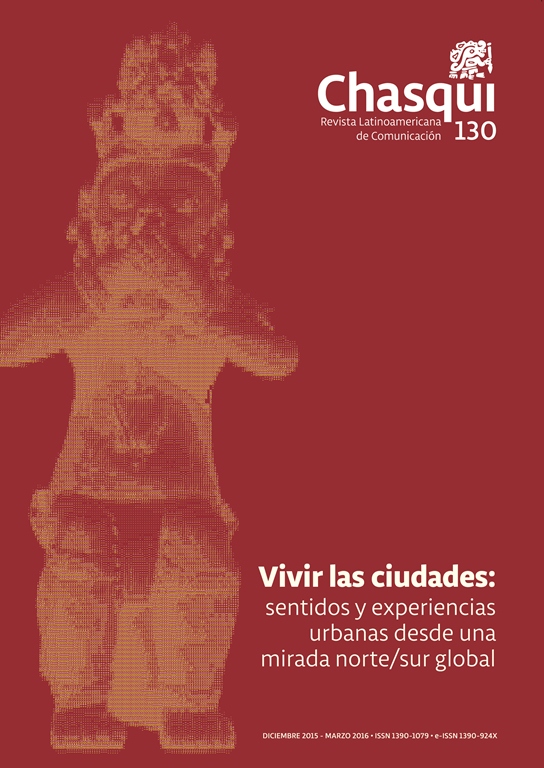Emerging ethnoscapes on the outskirts of Brasilia: migrants and their socio-cultural appropriation of the city
DOI:
https://doi.org/10.16921/chasqui.v0i130.2475Keywords:
ethnoscapes, intercultural communication, globalization, migrationAbstract
This article aims to address the emergence of ethnoscapes on the outskirts of Brasilia, located at the region of Samambaia Norte, with migrants from Pakistan, Bangladesh and Ghana. The proposal is getting back to the concept of ethnoscape. This need has been identified at fieldwork experience, for having found small changes that intercultural contacts develop on these locations, and moreover, pointing to the enriching power that the encounters with diversity provide. Therefore, along with the recreation of space, we would like to think the emergence of ethnoscapes on the outskirts of Brazilian cities to be able at discussing notions about solidarity, belonging, inclusion, through the contacts and encounters with the foreigners.References
Appadurai, A. (2004). Dimensões Culturais da Globalização. Lisboa: Editorial Teorema.
García Canclini, N. (2005). Diferentes, Desiguais e Desconectados: Mapas da Interculturalidade. Rio de Janeiro: Editora UFRJ.
Canevacci, M. (2005). Culturas eXtremas: mutações juvenis nos corpos das metrópoles. Rio de Janeiro: DP&A.
Canevacci, M. (2008). Fetichismos Visuais – Corpos Erópticos e Metrópole Comunicacional. São Paulo: Ateliê Editorial.
Castles, S. & Miller, M. (2009). The Age of Migration. Houndmills, Basingstoke, Hampshire and London: MacMillan Press ltd.
Czaika, M. & De Haas, H. (2013). The Globalization of Migration. Has the world really become more migratory? IMI Working Papers Series, No. 68.
Elias, N. (2000). Os Estabelecidos e os Outsiders: sociologia das relações de poder e partir de uma pequena comunidade. Rio de Janeiro: Jorge Zahar Editora.
Fellet, J. (2012, Enero 26). Refugiados denunciam maus-tratos em fábrica da Sadia. BBC Brasil. Recuperado de http://goo.gl/JYCNrS.
Hall, S. (1989). Ethnicity: Identity and Difference. Speech to Hampshire College, Amherst, Massachusetts.
Haesbaert, R.C. (2010). O Mito da Desterritorialização: do ‘fim dos territórios’ à multiterritorialidade. Rio de Janeiro: Betrand Brasil.
Martín-Barbero, J. (2004). Ofício de cartógrafo: travessias latino-americanas da comunicação na cultura. São Paulo: Edições Loyola.
Matsuki, (2013, Mayo 15). PF faz operação para combater trabalho escravo de imigrantes de Bangladesh. UOL Notícias. Recuperado de http://goo.gl/9Qf3nz.
Santos, M. (2002). Por uma outra Globalização: do pensamento único à consciência universal. Rio de Janeiro: Record.
Santos, M. (2006). A Natureza do Espaço: Técnica e Tempo, Razão e Emoção. São Paulo: Editora da Universidade de São Paulo.
Seyferth, G. (2010). Imigração e Nacionalismo: o discurso da exclusão e a política imigratória no Brasil. Em Garcia Castro, M. (org.) Migrações Internacionais: contribuições para políticas. Brasília: CNPD.
Simmel, G. (2006). Questões Fundamentais da Sociologia. Rio de Janeiro: Jorge Zahar Ed.
Sodré, M. (1999). Claros e Escuros: identidade, povo e mídia no Brasil. Petrópolis, RJ: Vozes.
Vertovec, S. (2015, Enero 20). Muslims, Immigrants and the Perception Gap. Huffington Post. Recuperado de http://goo.gl/4ppWTU.
Downloads
Published
Issue
Section
License
- Authors retain copyright and grant the journal right of first publication with the work simultaneously licensed under a Creative Commons Attribution-NoDerivs License (CC BY-ND) that allows others to share the work with an acknowledgement of the work's authorship and initial publication in this journal.
- Authors are able to enter into separate, additional contractual arrangements for the non-exclusive distribution of the journal's published version of the work (e.g., post it to an institutional repository or publish it in a book), with an acknowledgement of its initial publication in this journal.
- Authors are permitted and encouraged to post their work online.

